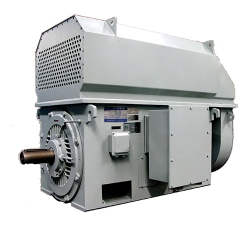The role of the stator of the high-voltage motor is to generate a magnetic field and serve as a mechanical support for the high-voltage motor.The stator of the motor is composed of three parts: the stator core, the stator winding and the frame.The stator windings are embedded in the stator core, and the induced electromotive force is generated when the current passes through to realize the conversion of electric energy.The main function of the frame is to fix and support the stator core.When the high-voltage motor is running, the heat generated due to internal loss is transmitted to the base through the iron core, and then radiated from the surface of the base to the surrounding air.In order to increase the heat dissipation area, the high-voltage motor is generally designed as a heat sink on the outer surface of the base.The rotor of a high-voltage motor is composed of a rotor core, a rotor winding and a rotating shaft.The rotor core is also part of the magnetic circuit of the motor.The role of the rotor winding is to induce electromotive force and generate electromagnetic torque through current.The shaft is the main component that supports the weight of the rotor, transmits torque, and outputs mechanical power.
A rotating electrical machine that converts DC electrical energy into mechanical energy (DC motor) or converts mechanical energy into DC electrical energy (DC generator).A rotating motor whose output or input is defined as DC power is called a DC motor. It is a motor that can convert between DC power and mechanical energy.When it is used as a motor, it is a DC motor, which converts electrical energy into mechanical energy; when it is used as a generator, it is a DC generator, which converts mechanical energy into electrical energy. DC motors are easier to control speed than AC motors, and can be applied to a wide range of speed adjustments. Occasion, it can be used for dynamic braking, but it is more and more complicated than the maintenance work of AC motor.

The three-phase symmetrical armature winding acts as a power winding and becomes the carrier of induced electric potential or induced current.Cutting movement: the prime mover drives the rotor to rotate (input mechanical energy to the motor), the excitation magnetic field between the polar phases rotates with the shaft and sequentially cuts the stator phase windings (equivalent to the winding conductor reverse cutting the excitation magnetic field).Generation of alternating electric potential: Due to the relative cutting motion between the armature winding and the main magnetic field, a three-phase symmetrical alternating electric potential whose size and direction change periodically will be induced in the armature winding.Through the lead wire, AC power can be provided.Alternation and symmetry: due to the alternating polarity of the rotating magnetic field, the polarity of the induced electric potential is alternating; due to the symmetry of the armature winding, the three-phase symmetry of the induced electric potential is guaranteed.